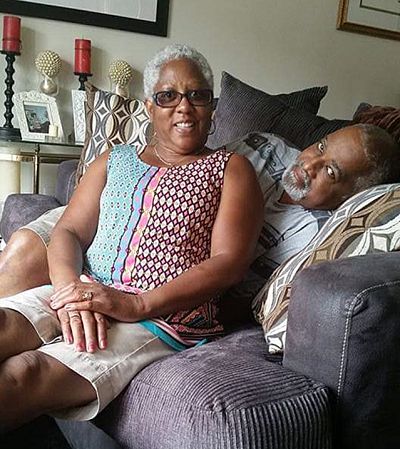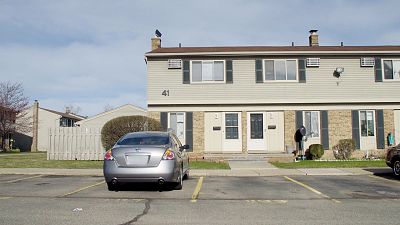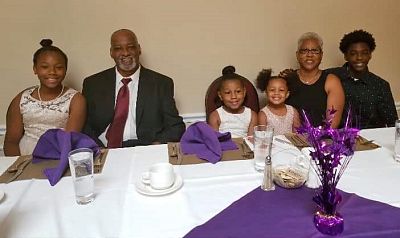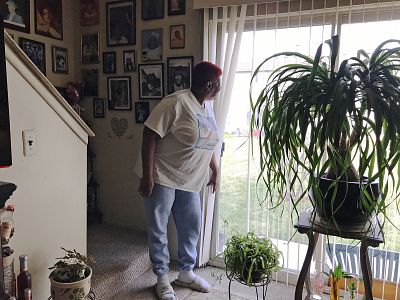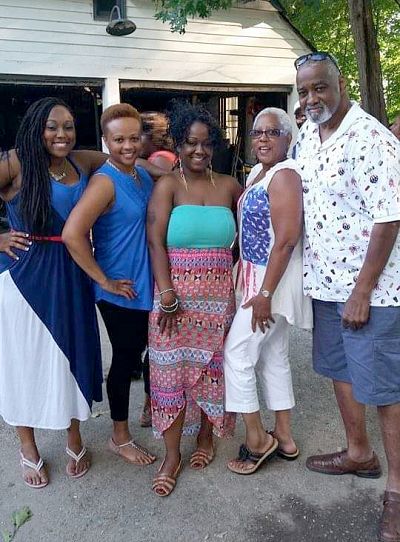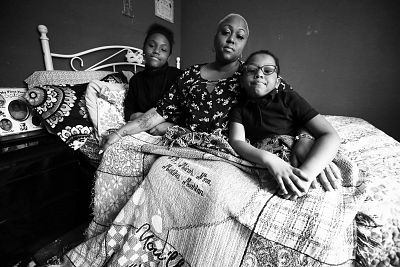The deadly gas had filled a Michigan couple's home, but no alarm was sounding. Millions of Americans in public housing may be at risk.
WAYNE, Mich. — It was already getting dark when Ashley Gunn pulled up to her parents' house with her three kids in the backseat. None of the lights were on, which she thought was a little strange.
It was a bitterly cold day in February, with temperatures barely climbing out of the single digits, on the heels of a record-breaking polar vortex. Before leaving for her parents' house at the Hickory Hollow Cooperative, the federally subsidized housing complex where they lived, Gunn called her mother to tell her she was on the way, but didn't get a response. Her mother must be busy, she thought, and headed over anyway.
Her father, Anthony Fleming, 64, would normally be sitting at the kitchen table facing the front windows, waving and smiling the moment he spotted his granddaughters. He would have already cooked their favorites — mac and cheese, chicken, spaghetti — and Gwendolyn, his wife of 35 years, might have cued up the movies they'd all watch together. The kids loved nothing better than going over to their grandparents' house, which always smelled like candles and delicious food.
But Anthony wasn't at the window to greet them. Gunn got out of the car with her husband and kids — aged 11, 6 and 3 — and knocked on their front door. No answer. She knocked again, yelling this time. Nothing. She dialed her oldest sister in a panic. "Something just doesn't feel right," Gunn's sister told her. "We'll call the police."
When the officers arrived, they broke through the back door. Minutes ticked by, then an ambulance and fire trucks pulled up, sirens blazing. Gunn felt momentarily relieved. "They wouldn't bring an ambulance if they weren't alive," she thought. The emergency responders wheeled her father out on a stretcher, unconscious, his eyes rolled back in his head.
She waited for a second stretcher carrying her 65-year-old mother. But none appeared. When a police officer finally pushed the master bedroom window all the way open, Gunn knew something was horribly wrong. "In my mind I'm thinking gas," she said.
Her mother was dead from carbon monoxide poisoning. The levels in her bedroom were higher than the fire department's carbon monoxide meter could measure, according to the department's incident report.
No alarms were sounding in their federally subsidized apartment when firefighters entered, the report noted. Carbon monoxide detectors are the only reliable way to detect the colorless, odorless gas, but they are not required in the 4.6 million affordable housing units overseen by the Department of Housing and Urban Development.
Just a day earlier, another Hickory Hollow resident had gone to the emergency room after the fire department found elevated carbon monoxide levels in her home, city records show; a similar incident happened at the complex in 2016. But the Flemings didn't know they were at risk.
Gunn broke down sobbing when a police officer pulled her aside to deliver the news about her mother. Her three children, who were sitting in the backseat of the car, also burst into tears. When the medical examiner arrived, Gunn knew she had to leave.
"I didn't want to see them bring my mother's body out in a body bag," she said. "And I didn't want my children to see that."
Her father was soon airlifted to a Toledo hospital, where Gunn stayed by his bedside. But he never regained consciousness.
"We went from planning one funeral to planning two," Gunn said.
A RISING TOLL
Like many of their neighbors, the Flemings had moved to Hickory Hollow because they wanted a quiet, safe place to live. The complex sits on the outskirts of Wayne, a small suburb of Detroit filled with modest ranch houses, medical facilities and senior citizen homes. The townhouse-style apartments at Hickory Hollow are scattered across 65 buildings in a private enclave; all have identical black shutters and tan-and-brick siding. The grassy grounds are lined with walkways and dotted with brightly colored sculptures. A golf course is across the street. It's a short drive to HUD Secretary Ben Carson's first childhood home.
Hickory Hollow is a co-op, so residents are shareholders in the corporation that owns the property, but they do not directly own real estate. About a third of residents receive HUD rental assistance for low-income families, including the Flemings, according to HUD records.
The property did well on its last mandatory health and safety inspection from HUD, receiving an 80 out of 100 in 2015, records show. But federal inspectors didn't assess whether any of the homes had working carbon monoxide detectors, because they aren't required by law in HUD housing.
The cause of the carbon monoxide buildup in the Flemings' home is still being determined, and police are conducting an investigation. A local fire official told Gunn on the night of the incident, Feb. 1, that his team found no carbon monoxide detectors during their walkthrough of her parents' home, Gunn said. A forensic engineer hired by the family's attorney also found no detectors during a Feb. 15 inspection, according to an email from the engineer reviewed by NBC News. (The city of Wayne declined to confirm whether detectors were missing or answer questions about what fire officials found.)
Maintenance staff told emergency responders that chimneys across the complex had iced up, and the ice obstructions were a "possible contributing factor to the CO levels," according to the fire department's incident report, obtained by NBC News through a Freedom of Information Act request.
The early signs of carbon monoxide poisoning include dizziness, headaches, weakness, confusion and an upset stomach, making them easy to mistake for other ailments. Many victims die in their sleep. Emergency responders found Anthony Fleming unresponsive in an armchair; his wife was found dead on her bed upstairs, according to the fire department's report.
News
The Flemings are part of a rising death toll from carbon monoxide poisoning in HUD housing. Since 2003, the gas has killed at least 13 public housing residents, by NBC News' count — four since the beginning of this year. That figure is compiled from media accounts and confirmed by local authorities. Just two weeks before the Flemings' death, two men died from carbon monoxide poisoning in a public housing complex in Columbia, South Carolina.
Public housing residents are particularly vulnerable to the hazard. Carbon monoxide is especially harmful to the elderly, who often have other health problems and are more likely to live in HUD housing; babies and young children are susceptible to carbon monoxide poisoning as well. Nationally, African Americans are also more likely to die from accidental carbon monoxide poisoning than other racial groups, according to a 2015 study conducted by researchers from the Centers for Disease Control and Prevention. Of the 13 HUD residents who have died from the gas since 2003, 10 were African American.
Despite these deaths, HUD has been slow to address the problem: The agency acted only after NBC News revealed the lack of protections for millions of low-income families in an investigation this year. Last month, HUD announced that it is drafting the first federal rule requiring CO detectors in public housing — a process that's likely to take months, if not years, to complete.
Politics
Carson has promised to make the new requirements a priority, and HUD says it is moving forward. "We don't signal our intent to do something and dillydally," agency spokesman Brian Sullivan said. But HUD has not given a timeline for action and could not estimate how long it would take, given the steps required by the federal rulemaking process. HUD only found out about the Hickory Hollow incident in early April after a resident contacted the agency, Sullivan noted, faulting the property's management for failing to inform HUD about safety and health hazards that were displacing residents. (The management did not respond to requests for comment.)
"HUD is investigating the circumstances surrounding these tragic deaths and we grieve the loss of Gwendolyn and Anthony Fleming," the agency said in a statement provided to NBC News. "Any death caused by carbon monoxide is one death too many."
At Hickory Hollow, the number of deaths could have been even higher. On the night the Flemings were found, fire officials detected elevated carbon monoxide levels in 26 units across the complex, forcing the families to be evacuated, according to city records obtained via FOIA. One of the apartments had a reading of 500 parts per million, according to the incident report — more than three times the level that the Consumer Product Safety Commission says can cause "disorientation, unconsciousness and death," and the maximum reading on the meter's scale.
That Friday night, Gunn's three children had been planning to stay over at the Flemings' house — they had a sleepover with their grandparents every other weekend. There was a giant California King bed in the master bedroom, so all five would often sleep there together. That's where emergency responders found Gwendolyn Fleming's body.
"If that incident had happened one day later," Gunn said, "my children would be dead."
'HOW MANY MORE PEOPLE HAVE TO DIE?'
The week before Gwendolyn Fleming died, her neighbor, Vanessa Daniels, began having a terrible headache. "I kept dozing off," Daniels said. She was lying in bed when her carbon monoxide alarm went off early Thursday morning.
When the fire department showed up, they found an elevated level of the gas throughout her two-story apartment, according to an incident report obtained through FOIA.
“It could have happened to me if my alarm didn’t work.”
Daniels, 63, went to the emergency room with dizziness, a headache and chest pain, and the doctor diagnosed her with exposure to the gas and anxiety, according to her medical records. That night, she was afraid to fall asleep, for fear that she wouldn't wake up, but she didn't have anywhere else to go.
The next day, Daniels saw the flashing lights of fire trucks, police and an ambulance outside the Flemings' house. "That hurt me to my heart," she said in tears. "It could have happened to me if my alarm didn't work."
The only reason that Daniels says that she had a detector in the first place was because dangerous levels of carbon monoxide had filled her neighbor's apartment at Hickory Hollow in November 2016. Three adults and a 5-year-old girl went to the emergency room on Thanksgiving Day, according to city records obtained through FOIA. One of the adults "woke up and felt like she could not breathe," and her husband would not get out of bed, the fire department said in its report, noting "very high" CO levels of more than 300 parts per million inside their home. All of them survived.
After the 2016 incident, the property managers installed carbon monoxide detectors in Daniels' apartment, she said. By the spring of 2017, they had finished installing detectors in all 267 units at Hickory Hollow, which uses gas-fired boilers, the property manager said in a December 2017 deposition obtained by NBC News. But no carbon monoxide alarms were sounding in the Flemings' apartment when the fire department arrived on Feb. 1, according to the incident report.
The fire department said detectors were missing from two other apartments in the Flemings' building that also had elevated carbon monoxide levels. The maintenance team "could not advise if every unit was equipped with a CO detector," the report said.
Politics
The Fleming family is now preparing to sue Hickory Hollow Cooperative and Huntington Management, which runs the property. Daniels is also planning a lawsuit, as she believes she still suffers from memory problems due to carbon monoxide poisoning, which can cause permanent brain damage and an elevated risk of heart disease. Another resident, Priscilla Jordan, has already sued Hickory Hollow and the management company, claiming their negligence "resulted in severe, permanent and irreversible" harm from carbon monoxide poisoning.
Hickory Hollow Cooperative, Huntington Management and an attorney representing both parties did not respond to requests for comment.
On the state and local level, there is a patchwork of laws and regulations that require detectors, but protections are limited, enforcement is spotty and some places have no requirements at all. Michigan passed a law in 2008 requiring detectors for new or remodeled homes, for instance. The city of Wayne requires carbon monoxide detectors in homes when they are sold and in rental housing, which must be inspected every three years. But Hickory Hollow is not subject to the same schedule of rental inspections since it is a housing cooperative, not a traditional rental property, and the last city inspection of the Flemings' home was in 2007, before the city's carbon monoxide requirements went into effect, according to Michael Buiten, the city's engineering manager.
Given such limited protections, residents question why HUD had not acted more quickly to require working carbon monoxide detectors in public housing. "That should be your top priority — there should be no question," Daniels said. "The cost to put that in shouldn't even measure up to losing a life."
Housing advocates are now urging HUD to move quickly on its plans to require carbon monoxide detectors. The agency has yet to release a proposed rule, the first step in the long process of creating a new regulation. Congress could also take action: Bills introduced in the House and Senate would require detectors in all federally assisted housing and provide $10 million for installing them. But neither chamber of Congress has moved forward with the proposal.
"How many more people have to die under the government's watch?" said Rep. Jesus "Chuy" Garcia, D-Ill., who co-sponsored the House bill.
A SAFE HOME
Gwendolyn Fleming was raised in a Detroit public housing project that was torn down just a few years ago due to deteriorating conditions. Having grown up poor, Gwendolyn always hammered away on the importance of education to her three daughters. She and her husband both worked full-time to pay for things her family struggled to afford when she was growing up — new clothes instead of hand-me-downs, or a Disney World vacation. She was a certified surgical technologist; Anthony Fleming worked as a shipping clerk, then later became a maintenance technician at a children's hospital.
Anthony was a big man with a booming voice that rang out when he yelled, but he rarely stayed angry for long. "I remember him disciplining us, [then] taking us to the mall afterward because he felt bad — taking us to the movies," said his daughter Alicia Greer, 34. When the girls' mother had to work late, their father washed their hair and put it up in ponytails; he cooked dinner for them every night. All three daughters graduated from college. Greer now does medical billing for a cancer lab in Texas; Gunn is a security supervisor at a high school near Detroit; and Monique Jelks, 48, is an operations manager at an Indianapolis hospital.
But Anthony and Gwendolyn Fleming faced mounting financial pressure as they grew older, especially after Anthony hurt his back in 2011 and was forced to quit his job, according to Gunn. Through the Section 8 program, they received federal assistance to afford a place to live out their retirement years. They paid about $570 a month for their two-bedroom apartment at Hickory Hollow, according to a copy of their 2013 housing agreement obtained by NBC News, and HUD covered the rest.
From the outside, Hickory Hollow, built in 1971, looks like clean and well-kept. Families like the Flemings took pride in tending to their homes and adding personal touches, and there are strict rules governing everything from visitor parking to trash collection. "It's a small community — there's not a lot of crime or anything like that," Jelks said. "My parents felt very comfortable moving there."
But some residents also grumbled about aging appliances and maintenance delays, according to interviews with Daniels, Jordan and the Flemings' children. About two weeks before the incident, their parents complained that "the boiler was old, there was no maintenance on it for a long time," Gunn said. The boiler itself was blackened with soot, according to photos provided to NBC News by Matthew Curtis, an attorney for the family, who alleges that "poor maintenance, poor ventilation, and a poorly functioning old boiler unit" were responsible for the fatal levels of carbon monoxide.
Gunn believes Washington would have been far quicker to protect families from carbon monoxide poisoning had the previous deaths happened in wealthier communities. Instead, "these are low-income people, and it's almost like, 'We don't care about them,'" she said.
"Those are still lives. Those are still people that are loved."
'ARE THEY STILL IN HEAVEN?'
The Christmas decorations are still up in the Flemings' back patio, hanging over the white gardening gloves that Gwendolyn left behind, as if she had just stepped into the house for a moment. By now, she would have planted her spring flowers, and her husband would have been itching to start up the grill.
Instead, Gunn's 3-year-old bursts into tears every time she hears an ambulance or fire truck, calling out "Gigi! Gigi!" — her grandmother's family nickname. "Are they still in heaven?" she keeps asking her mother. "Can we go visit them?"
Gwendolyn was buried with a pillow covered with pictures of her grandchildren, which Gunn tucked inside her casket. She left behind a letter for her husband, since she always sensed she'd die first, as well as gifts for each of her five grandchildren — a collection of special coins, a $2 bill, and other quirky objects she thought they'd like. Gunn's 11-year-old daughter Nina put the keepsakes in a shoebox in her room. "It makes me feel happy and safe," she said. On her desk, she has a page torn out of her journal, dated a few days after the funeral. "After losing two great grandparents, it's hard for me to focus on some things," Nina wrote.
The Flemings are buried in a tree-lined Detroit cemetery, less than three miles from the housing project where Gwendolyn grew up. Gunn and her sisters say they've barely allowed themselves to grieve, focusing instead on legal matters, logistics and paperwork, and running after their own children. But then there are moments when everything breaks open.
Gunn recently found a video clip from her sister Alicia's wedding in 2016. She and her two sisters were all on the dance floor during the reception, when her mother decided to join them. "Go momma, go momma!" her daughters shouted as Gwendolyn raised her arms and started dancing.
Watching the clip, Gunn was overcome. "My mom had on this pretty purple dress," she recalled. "It was the same dress we buried her in."












